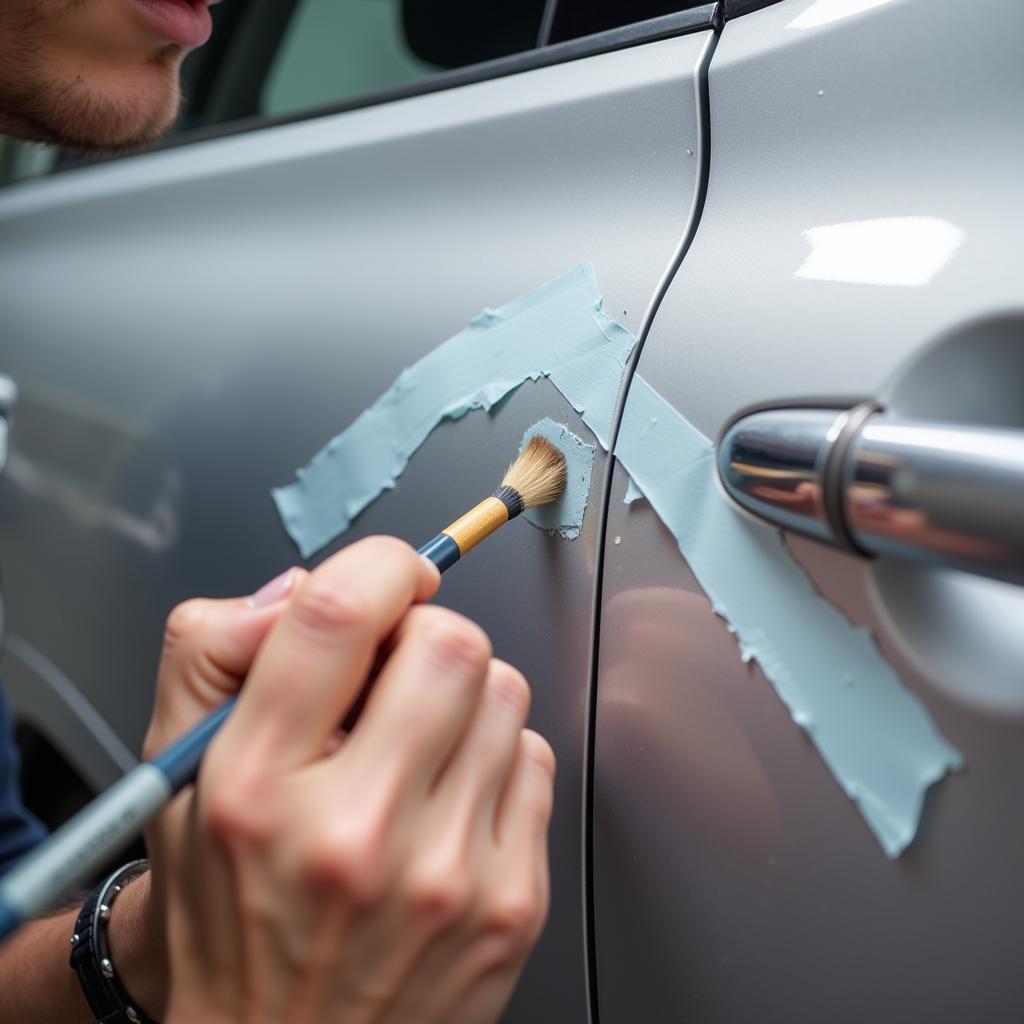Car Glass Fixing Silicone is crucial for safe and effective windshield repair and replacement. Choosing the right type and applying it correctly ensures a long-lasting, watertight seal that protects your car’s structural integrity and your safety on the road. This guide delves into the world of car glass fixing silicone, providing expert advice for DIY enthusiasts and professionals alike.
What is car glass fixing silicone, and why is it important? Simply put, it’s a specialized adhesive designed to bond auto glass to the vehicle frame. It creates a weatherproof seal, prevents leaks, and strengthens the chassis. A properly applied silicone bead is vital for maintaining the structural integrity of your vehicle in case of an accident. Thinking about fixing your car windows? Check out this helpful guide.
Choosing the Right Car Glass Fixing Silicone
Selecting the correct silicone is paramount. Consider these factors:
- Type of Silicone: Urethane-based silicones are the industry standard due to their strong adhesion, flexibility, and weather resistance.
- Moisture Cure vs. Primerless: Moisture-cure silicones require atmospheric moisture to cure, while primerless versions don’t need a separate primer, saving time and effort.
- Color: Black is the most common, but clear silicone is available for specific applications.
- Viscosity: The thickness of the silicone affects its application. Choose a viscosity suitable for your project and application method.
Not sure about fixing that leaky sunroof? Here’s how to fix car sunroof.
How to Apply Car Glass Fixing Silicone Like a Pro
Applying car glass fixing silicone properly is essential for a strong and lasting bond. Here’s a step-by-step guide:
-
Prepare the Surface: Clean both the glass and the frame thoroughly with a glass cleaner and an appropriate adhesive remover. Ensure surfaces are dry and free of dust, grease, and old silicone.
-
Apply Primer (if necessary): If using moisture-cure silicone, apply a thin, even coat of primer to both bonding surfaces. Allow it to dry according to the manufacturer’s instructions.
-
Load the Caulking Gun: Insert the silicone cartridge into the caulking gun, ensuring it’s properly seated. Cut the nozzle at a 45-degree angle to the desired bead size.
-
Apply the Silicone Bead: Apply a continuous, even bead of silicone to the frame, ensuring consistent thickness. Avoid gaps or air pockets.
-
Install the Glass: Carefully position the glass onto the frame, pressing firmly and evenly to distribute the silicone.
-
Cure Time: Allow the silicone to cure completely according to the manufacturer’s instructions before driving the vehicle.
Do your car windows make annoying screeching sounds? Learn how to fix car window screeching.
Common Mistakes to Avoid
- Using the Wrong Silicone: Using general-purpose silicone can lead to leaks and poor adhesion.
- Insufficient Surface Preparation: Dirt, grease, and old silicone will prevent proper bonding.
- Applying Too Much or Too Little Silicone: An uneven bead can weaken the seal.
- Not Allowing Sufficient Cure Time: Driving before the silicone cures fully can compromise the bond.
Ever considered using car glass fixing gum? Check out car glass fixing gum for more information.
“Proper surface preparation is the key to a successful car glass installation. Don’t rush this crucial step,” advises John Miller, a veteran auto glass technician with over 20 years of experience.
Troubleshooting Car Glass Fixing Silicone Issues
- Leaks: If you notice leaks after installation, inspect the silicone bead for gaps or inconsistencies. You may need to remove the glass, clean the surfaces, and reapply the silicone.
- Debonding: If the glass separates from the frame, it may be due to improper surface preparation, the wrong type of silicone, or insufficient cure time. Consult a professional if necessary.
“Always choose a high-quality urethane-based silicone specifically designed for auto glass applications,” recommends Sarah Johnson, an automotive engineer specializing in adhesive technologies.
Conclusion
Car glass fixing silicone is essential for a safe and reliable windshield repair or replacement. Choosing the right silicone and applying it correctly are crucial for a long-lasting, weathertight seal. By following the steps outlined in this guide and avoiding common mistakes, you can ensure a professional-quality result, whether you’re a DIY enthusiast or a seasoned professional. Need help with your 2009 Mazda’s window? Learn how to fix mazda car window 2009. For personalized assistance, connect with us at AutoTipPro at +1 (641) 206-8880 or visit our office at 500 N St Mary’s St, San Antonio, TX 78205, United States.
FAQ
- What is the best type of silicone for car glass fixing? Urethane-based silicones are the preferred choice for their superior adhesion, flexibility, and weather resistance.
- How long does car glass fixing silicone take to cure? Cure times vary depending on the specific product, temperature, and humidity. Always refer to the manufacturer’s instructions.
- Can I use regular silicone for car glass fixing? No, regular silicone is not designed for automotive applications and will not provide a strong or lasting bond.
- How do I remove old car glass fixing silicone? Use a specialized silicone remover and a scraper to carefully remove the old silicone without damaging the surrounding surfaces.
- What should I do if my car glass leaks after applying silicone? Inspect the silicone bead for gaps or inconsistencies. You may need to remove the glass and reapply the silicone.
- Is it safe to drive immediately after applying car glass fixing silicone? No, always allow the silicone to cure completely according to the manufacturer’s instructions before driving the vehicle.
- Where can I buy car glass fixing silicone? Automotive parts stores, hardware stores, and online retailers typically carry car glass fixing silicone.





Leave a Reply